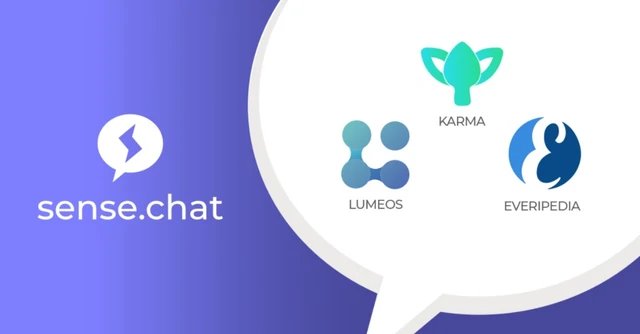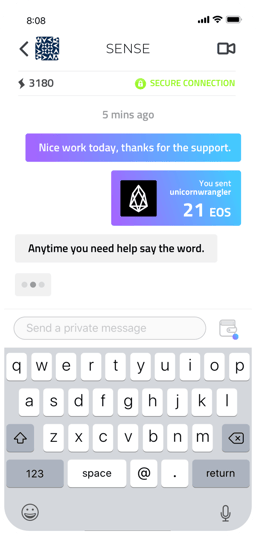Sense.Chat

Sense.Chat
Overview
Released in March of 2019, Sense.Chat
is the first decentralized messaging platform with smart connections and contacts, powered by the EOS blockchain. Sense.Chat allows users to earn, send, and receive digital assets as they chat. Transactions are ultra-fast on EOS and no one can steal your data because it is never stored. [1]
CEO Crystal Rose said:
"You shouldn't have to compromise your digital-self to have a conversation online.
With blockchain technology, the digital world can react in the same way as the physical world. Conversations on Sense.Chat are like having conversations in real life. No middlemen spying on your message or selling your data.”
Bitcoin maximalist Timothy C. Draper officially joined the Board of Directors of Sense.Chat's parent company, MakeSense Labs in September of 2019. [19]
On November 4, 2019, Everipedia, KARMA, and Lumeos launched communities on Sense.Chat . Sense.Chat
users
can share these tokens and chat in the #everipedia, #karma, #lumeos channels. [18]
History
Crystal Rose and Ariel Jalali co-founded Sensay in 2014 as an anonymous chat-bot platform that aimed to connect people with experts about any question they have. Unlike Sense.chat, Sensay was built on the Ethereum blockchain and quickly bootstrapped to a community of three million+. [8]
The SENSE network expanded on the Sensay template and developed CryptoDM, a paid inbox service for influencers and celebrities to earn cryptocurrency for their attention. The idea eventually evolved into Sense.Chat. [16]
In September 2020, Sense launched the beta version of their revamped Sense Chat app on iOS and Android (OS) with new features including:
E2E Encrypted 1:1 and Group Chats
Threaded responses [21]
Vouching
Send/receive $SENSE
Earning $SENSE daily
Pumping messages with $SENSE
Creating/joining channels
How It Works
Encryption protocol for private messaging normally works like this: two parties each receive their own private keys which are stored in a central server. When party A sends a message to party B, party A signs party B's public key with their own private key. This proves to party B that Party A is, in fact, party A. Party B, in return, does the same thing to verify their identity. The exchange of data becomes a "shared secret" which is then used to encrypt and decrypt communication between parties. [17]
While this facilitates privacy, it leaves loopholes that allow impersonation and create a security risk if someone is able to access a user's email or phone number. One of Sense.Chat's engineers, Angel Jose, conceptualized a novel technique to solve these issues. He found that sending messages that are encrypted with the public key of the recipient and stored on and referenced from the EOS blockchain solved a lot of issues affecting private messaging supported by traditional encryption protocol. This allows Sense.Chat to avoid transmitting or receiving keys from a central server. [17]
Sense.Chat
uses Diffie–Hellman key exchange to achieve anonymous key agreement. Diffie-Hellman describes a method of generating a shared secret in two different locations without exchanging information between those two locations. Sense.Chat uses ECDHE-256 to create a shared secret based off of the two users' EOS account keys plus an entropic value. The shared secret is created on both users’ devices simultaneously. This way, the shared secret only lives on those two devices and is used to secure the session. [17]
Sense.Chat
Video and Audio calls are secured by TLS over WebRTC. [17]




